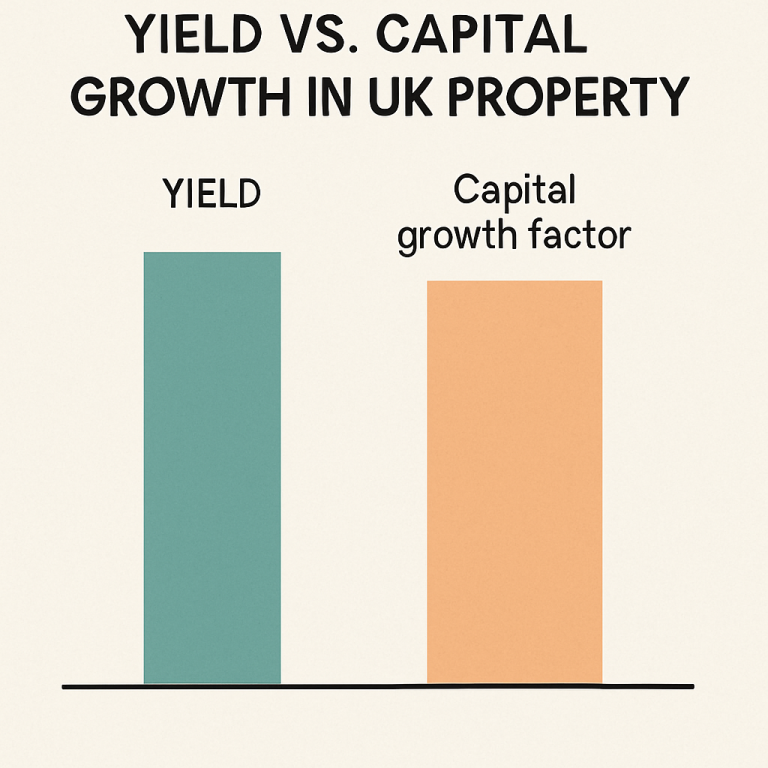Navigating the UK property market in 2025 requires a keen understanding of yield versus capital growth. Investors often face the dilemma of choosing between these two strategies. Yield refers to the income generated from a property, while capital growth focuses on the increase in property value over time.
Both strategies have their merits and challenges. The right choice depends on individual investment goals and market conditions.
In recent years, cities like Manchester and Birmingham have offered attractive yields. Meanwhile, London remains a hotspot for capital growth, despite its high property prices.
Understanding the balance between yield and growth is crucial for long-term success. Economic factors, such as interest rates and inflation, play a significant role.
Government policies and market trends also influence property investment strategies.
This article explores which UK cities offer the best investment mix in 2025.
Understanding Yield vs Capital Growth in UK Property Investment
When investing in UK property, understanding yield and capital growth is fundamental. Yield is the income return on an investment property, typically represented as a percentage of its cost. This financial metric helps investors gauge the profitability of their rental investments.
Capital growth, on the other hand, signifies the increase in property value over time. This growth is influenced by market conditions and local development. Investors focusing on capital growth often seek properties in regions with strong economic prospects.
Both yield and capital growth are essential, but the emphasis varies with investor goals.
Here’s a breakdown of their key aspects:
- Yield: Regular income, rental market influence, short-term returns
- Capital Growth: Long-term value increase, economic growth impact, appreciation potential
Understanding these elements can help investors tailor their strategies. London’s thriving economy often supports capital growth. Meanwhile, cities like Liverpool offer more attractive yields due to lower property prices.
Choose wisely to balance income and appreciation. This requires analyzing the local market, infrastructure plans, and demographic trends.

Key UK Property Trends Shaping 2025
The UK property market is constantly evolving. As we look towards 2025, several key trends are emerging. These trends will likely shape investment decisions and market dynamics.
One significant trend is the impact of remote working. With more people working from home, demand for properties in suburban and regional areas is rising. This shift opens new opportunities for investors.
Economic factors also play a crucial role. Interest rates and inflation can affect property values and rental yields. Investors should closely watch these indicators to anticipate market shifts.
Infrastructure development, such as new transport links, can significantly influence property markets. Areas with major infrastructure projects tend to experience both yield enhancement and capital growth.
Here are some key trends to watch:
- Remote work affecting housing demand
- Economic factors like interest rates
- Infrastructure developments enhancing value
Keeping an eye on these trends can help investors make informed decisions in the dynamic UK property market.
Investment Yield Analysis: How to Assess UK Property Yields
Understanding investment yield is essential for property investors. Yield measures the income return on an investment. It’s typically expressed as a percentage of the property’s cost or value.
There are different yield types to consider. Gross yield calculates the annual rental income as a percentage of the property price. Net yield accounts for costs like maintenance and taxes, giving a clearer financial picture.
Assessing UK property yields requires detailed analysis. Investors must consider location-specific factors. These include rental demand and local economic conditions, which significantly impact potential yields.
To effectively analyze property yields, consider:
- Rental income relative to property cost
- Local economic indicators
- Property-related expenses and taxes
A thorough yield analysis equips investors with insights to make informed decisions. By understanding the nuances of yield, investors can better predict returns and manage risks in property ventures.
Capital Growth Explained: What Drives Value in UK Cities?
Capital growth represents the increase in a property’s value over time. It is a key goal for many property investors, aiming for long-term value appreciation.
Several factors drive capital growth in UK cities. Economic vitality is crucial; cities with strong job markets tend to see better property value increases.
Infrastructure developments can also boost capital growth. New transport links and urban regeneration projects often attract more residents and businesses, enhancing property demand.
Local market conditions are equally important. Supply and demand dynamics can significantly influence property value changes. When demand outstrips supply, prices usually rise.
Key drivers of capital growth include:
- Economic development and employment rates
- Infrastructure improvements
- Population growth and urban policies
Keeping an eye on these factors can help investors anticipate value increases. By understanding what fuels capital growth, investors can capitalize on favorable trends and maximize returns over time.
Yield vs Growth: Which Strategy Suits Different Investor Profiles?
Choosing between yield and growth strategies depends largely on individual investment goals and risk tolerance. Yield-focused investors generally prioritize regular income, ideal for those seeking cash flow or nearing retirement.
On the other hand, growth-oriented investors aim for property value appreciation. They might be willing to endure short-term market fluctuations for long-term gains.
Understanding your financial goals can guide your strategy choice. For stable income, prioritize yield; for wealth accumulation, focus on growth.
Key factors to consider when deciding include:
- Current financial situation and cash flow needs
- Investment timeline and retirement plans
- Risk tolerance and market perception
Investors might also blend both strategies. By diversifying their portfolio, they can achieve a balance between immediate income and future capital appreciation. Tailoring your strategy to your unique profile ensures alignment with your financial objectives.
Top UK Cities for High Yields in 2025
In 2025, several UK cities are expected to deliver high rental yields. These cities attract investors seeking stable income streams. High-yield properties typically offer better cash flow, crucial for immediate financial returns.
Manchester is a standout city. It has consistently shown strong rental yields due to its vibrant economy and large student population. Properties here often yield above the national average, appealing to income-focused investors.
Liverpool is also gaining attention. Its affordable housing market and growing rental demand contribute to its high yield potential. As the city expands economically, more tenants seek housing.
Birmingham offers another promising landscape for yield seekers. Known for its regeneration projects, the city is becoming an attractive location for renters. This drives rental yield figures up, making it a hot spot for investors.
Key considerations when targeting high-yield cities include:
- Tenant demand and local employment rates
- Housing affordability relative to rental rates
Investors should also evaluate infrastructure developments. New transport links and commercial developments can boost rental demand and improve yield prospects.
Cities with Expected High Yields:
- Manchester
- Liverpool
- Birmingham
by Marek Lumi (https://unsplash.com/@mareklumi)
Understanding local market conditions and tenant demographics is vital. This knowledge aids in selecting the right property type and location.
Investing in high-yield areas requires diligent analysis and research. Ensure you align property choices with your income objectives to maximize returns.
Top UK Cities for Capital Growth in 2025
For investors focused on capital growth, specific UK cities offer promising prospects. These cities are noted for their increasing property values and strong economic fundamentals.
London, while historically expensive, often leads in capital growth. Its property market attracts international investors, banking on potential future price hikes. Areas undergoing regeneration see the most significant increases in property values.
Edinburgh is another city worth attention. It combines a thriving economy with a picturesque setting, drawing both local and international interest. Property prices here are projected to rise steadily, presenting growth opportunities.
Bristol stands out for its innovation-driven economy. The city’s tech sector expansion contributes to rising property demand and value. Investors see Bristol as a hub for future capital growth due to its dynamic economic landscape.
When evaluating cities for capital growth potential, consider:
- Economic indicators and employment growth
- Planned urban regeneration projects
Reviewing governmental policies is also vital. Tax incentives and infrastructure investments can significantly influence property value appreciation.
Cities with Promising Capital Growth:
- London
- Edinburgh
- Bristol
Diversifying across locations with growth potential helps manage risks. Investors should stay informed about local market movements to capitalize on emerging opportunities.
By focusing on cities with solid growth indicators, investors can position themselves for long-term gains. Balancing risk with potential returns remains key to a successful investment strategy.
The Best Investment Mix: Cities Balancing Yield and Growth
Successful property investment often requires a balance between yield and capital growth. Some UK cities offer this enticing combination, making them ideal for well-rounded portfolios.
Manchester is a prime example. Known for its robust rental yields, it also promises steady capital growth. The city’s diverse economic base supports stable property value rises alongside lucrative rental income.
Leeds presents another opportunity. With its growing economy and student population, it offers attractive yields. Meanwhile, ongoing urban regeneration projects boost long-term capital growth prospects.
Considering both yield and growth means evaluating:
- Economic diversity and resilience
- Education institutions attracting tenants
For investors seeking dual benefits, look to cities like Birmingham. Its strategic location and improving infrastructure enhance both rentability and property value appreciation.
Cities Balancing Yield and Growth:
- Manchester
- Leeds
- Birmingham
Navigating the fine line between yield and growth ensures a balanced investment strategy. Investors should analyze:
- Market supply and demand factors
- Local developments impacting future value
By targeting cities with a proven mix of yield and capital growth, investors can achieve consistent returns. Identifying locations that align with both income and appreciation goals can optimize investments over time.
Factors Influencing Yield and Capital Growth in 2025
Multiple factors will shape property yields and capital growth in 2025. Economic conditions, such as interest rates, strongly affect investment performance.
Changes in government policy also play a crucial role. Tax regulations, for instance, can significantly impact property profitability and attractiveness to investors.
Key influences to monitor include:
- Economic factors: Interest rates, inflation, economic growth
- Government policies: Taxation, housing regulations, incentives
- Infrastructure development: Transport links, urban regeneration
Another critical aspect is infrastructure. New transport links and urban improvements can enhance both yield and growth prospects by boosting demand and property values.
Moreover, technological advancements and remote work trends will continue to impact housing demands. Investors need to stay adaptable to these evolving dynamics to maximize potential returns.
Understanding these factors allows investors to make informed decisions, ensuring their strategies align with the changing property landscape of 2025.
Case Studies: Comparing Investment Outcomes in Leading Cities
Analyzing case studies from leading UK cities provides valuable insights. These examples highlight the differences between yield and capital growth. Let’s delve into a couple of noteworthy cases.
Manchester has consistently offered high rental yields. Investors here benefit from strong demand driven by a vibrant job market and student population.
On the other hand, London remains a capital growth center despite recent market fluctuations. High property values have limited yield opportunities but long-term value appreciation remains a strong selling point.
Consider these observations:
- Manchester: High yield due to rental demand and stable employment.
- London: Capital growth driven by international appeal and market resilience.
Another fascinating city is Birmingham. It combines both high yield potential and promising growth prospects. Urban revitalization efforts contribute to its attractiveness for investors.
By examining these cities, investors can discern which properties align with their specific investment strategies. Each city presents unique opportunities, depending on the chosen balance of yield vs growth.
Practical Tips for UK Property Investors in 2025
In 2025, property investors should adopt a strategic approach. Navigating the UK’s dynamic market requires both caution and readiness to seize opportunities. Here are some practical tips to guide your investment decisions.
Staying updated on economic indicators is crucial. Monitor interest rates, inflation trends, and government policies. These factors can significantly impact property values and yields.
Consider the following strategies:
- Diversify: Mix yield-focused and growth-focused investments for balanced risk.
- Research: Understand local market dynamics and demographic shifts.
It’s important to keep location in mind. Areas benefiting from infrastructure projects or economic growth initiatives can offer better returns.
Long-term success in property investment often hinges on these factors:
- Management: Effective property management enhances yield sustainability.
- Technology: Use data analytics for informed investment decisions.
By following these practical tips, UK property investors can maximize their returns. A well-rounded strategy that adapts to market conditions will stand the test of time.
Conclusion: Making the Right Choice for Your Investment Goals
Choosing between yield and capital growth depends on your investment goals. Both strategies have unique benefits and risks.
Prioritize understanding market trends and local factors that influence property performance. This knowledge enables you to make informed choices in the evolving UK property landscape. Balancing yield and growth can optimize your portfolio. With the right approach, you’ll be well-positioned for success in 2025 and beyond.


